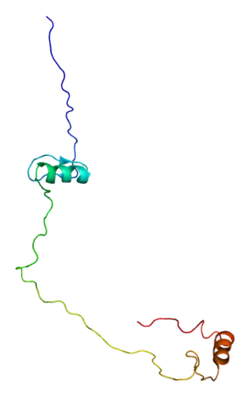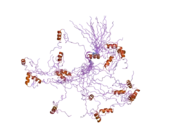TSHZ3
Teashirt homolog 3 is a protein that in humans is encoded by the TSHZ3 gene.[5] In mice, it is a necessary part of the neural circuitry that controls breathing. The gene is also a homolog of the Drosophila melanogaster teashirt gene, which encodes a zinc finger transcription factor important for development of the trunk.[6]
Tshz3-knockout mice do not develop the respiratory rhythm generator (RRG) neural circuit, which is a pacemaker that produces an oscillating rhythm in the brainstem and controls autonomous breathing. The RRG neurons are present, but are abnormal. Those mice do not survive because they don't initiate breathing after birth. Tshz3 is being studied for its relationship to infant breathing defects in humans.[7]
TSHZ3 has been identified as a critical region for a syndrome associated with heterozygous deletions at 19q12-q13.11, which includes autism spectrum disorder (ASD) symptoms such autistic traits, speech disturbance and intellectual disability, as well as renal tract abnormalities. Mice with heterozygous Tshz3 deletion (Tshz3lacZ/+) show enrichment of ASD-related gene orthologs in the cerebral cortex, functional alterations of corticostriatal circuitry and ASD-relevant behavioral abnormalities. [8]
Postnatal conditional deletion of Tshz3 in mouse induces behavioral deficits mimicking ASD, as well as abnormalities in synaptic transmission and plasticity in the corticostriatal circuit. These changes are associated to dysregulation of the cortical expression of more than 1000 genes, in particular coding for synaptic components, half of which has human orthologues involved in ASD.[9]
References
- GRCh38: Ensembl release 89: ENSG00000121297 - Ensembl, May 2017
- GRCm38: Ensembl release 89: ENSMUSG00000021217 - Ensembl, May 2017
- "Human PubMed Reference:". National Center for Biotechnology Information, U.S. National Library of Medicine.
- "Mouse PubMed Reference:". National Center for Biotechnology Information, U.S. National Library of Medicine.
- "Entrez Gene: TSHZ3 teashirt family zinc finger 3".
- Fasano L, Röder L, Coré N, Alexandre E, Vola C, Jacq B, Kerridge S (January 1991). "The gene teashirt is required for the development of Drosophila embryonic trunk segments and encodes a protein with widely spaced zinc finger motifs". Cell. 64 (1): 63–79. doi:10.1016/0092-8674(91)90209-h. PMID 1846092. S2CID 39211509.
- Caubit X, Thoby-Brisson M, Voituron N, Filippi P, Bévengut M, Faralli H, et al. (July 2010). "Teashirt 3 regulates development of neurons involved in both respiratory rhythm and airflow control". The Journal of Neuroscience. 30 (28): 9465–76. doi:10.1523/JNEUROSCI.1765-10.2010. PMC 6632443. PMID 20631175. Lay summary – New Scientist.
- Caubit X, Gubellini P, Andrieux J, Roubertoux PL, Metwaly M, Jacq B, et al. (November 2016). "TSHZ3 deletion causes an autism syndrome and defects in cortical projection neurons". Nature Genetics. 48 (11): 1359–1369. doi:10.1038/ng.3681. PMC 5083212. PMID 27668656.
- Chabbert D, Caubit X, Roubertoux PL, Carlier M, Habermann B, Jacq B, et al. (August 2019). "Postnatal Tshz3 Deletion Drives Altered Corticostriatal Function and Autism Spectrum Disorder-like Behavior". Biological Psychiatry. 86 (4): 274–285. doi:10.1016/j.biopsych.2019.03.974. PMID 31060802. S2CID 85532974.
Further reading
- Olsen JV, Blagoev B, Gnad F, Macek B, Kumar C, Mortensen P, Mann M (November 2006). "Global, in vivo, and site-specific phosphorylation dynamics in signaling networks". Cell. 127 (3): 635–48. doi:10.1016/j.cell.2006.09.026. PMID 17081983. S2CID 7827573.
- Mehrle A, Rosenfelder H, Schupp I, del Val C, Arlt D, Hahne F, et al. (January 2006). "The LIFEdb database in 2006". Nucleic Acids Research. 34 (Database issue): D415-8. doi:10.1093/nar/gkj139. PMC 1347501. PMID 16381901.
- Wiemann S, Arlt D, Huber W, Wellenreuther R, Schleeger S, Mehrle A, et al. (October 2004). "From ORFeome to biology: a functional genomics pipeline". Genome Research. 14 (10B): 2136–44. doi:10.1101/gr.2576704. PMC 528930. PMID 15489336.
- Brandenberger R, Wei H, Zhang S, Lei S, Murage J, Fisk GJ, et al. (June 2004). "Transcriptome characterization elucidates signaling networks that control human ES cell growth and differentiation". Nature Biotechnology. 22 (6): 707–16. doi:10.1038/nbt971. PMID 15146197. S2CID 27764390.
- Wiemann S, Weil B, Wellenreuther R, Gassenhuber J, Glassl S, Ansorge W, et al. (March 2001). "Toward a catalog of human genes and proteins: sequencing and analysis of 500 novel complete protein coding human cDNAs". Genome Research. 11 (3): 422–35. doi:10.1101/gr.GR1547R. PMC 311072. PMID 11230166.
- Hartley JL, Temple GF, Brasch MA (November 2000). "DNA cloning using in vitro site-specific recombination". Genome Research. 10 (11): 1788–95. doi:10.1101/gr.143000. PMC 310948. PMID 11076863.
- Nagase T, Kikuno R, Ishikawa K, Hirosawa M, Ohara O (April 2000). "Prediction of the coding sequences of unidentified human genes. XVII. The complete sequences of 100 new cDNA clones from brain which code for large proteins in vitro". DNA Research. 7 (2): 143–50. doi:10.1093/dnares/7.2.143. PMID 10819331.
External links
- Overview of all the structural information available in the PDB for UniProt: Q63HK5 (Teashirt homolog 3) at the PDBe-KB.





